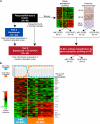Differential efficacy of bortezomib plus chemotherapy within molecular subtypes of diffuse large B-cell lymphoma
- PMID: 19380866
- PMCID: PMC2699229
- DOI: 10.1182/blood-2009-01-199679
Differential efficacy of bortezomib plus chemotherapy within molecular subtypes of diffuse large B-cell lymphoma
Abstract
Gene expression profiling of diffuse large B-cell lymphoma (DLBCL) has revealed distinct molecular subtypes that include germinal center B cell-like (GCB) and activated B cell-like (ABC) DLBCL. ABC DLBCL has a worse survival after upfront chemotherapy and is characterized by constitutive activation of the antiapoptotic nuclear factor-kappa B (NF-kappaB) pathway, which can inhibit chemotherapy. We hypothesized that inhibition of NF-kappaB might sensitize ABC but not GCB DLBCL to chemotherapy and improve outcome. As the proteasome inhibitor bortezomib can inhibit NF-kappaB through blocking IkappaBalpha degradation, we investigated bortezomib alone followed by bortezomib and doxorubicin-based chemotherapy in recurrent DLBCL. Tumor tissue was analyzed by gene expression profiling and/or immunohistochemistry to identify molecular DLBCL subtypes. As a control, we showed that relapsed/refractory ABC and GCB DLBCL have equally poor survivals after upfront chemotherapy. Bortezomib alone had no activity in DLBCL, but when combined with chemotherapy, it demonstrated a significantly higher response (83% vs 13%; P < .001) and median overall survival (10.8 vs 3.4 months; P = .003) in ABC compared with GCB DLBCL, respectively. These results suggest bortezomib enhances the activity of chemotherapy in ABC but not GCB DLBCL, and provide a rational therapeutic approach based on genetically distinct DLBCL subtypes. This trial is registered with http://www.ClinicalTrials.gov under identifier NCT00057902.
Figures


References
-
- Alizadeh AA, Eisen MB, Davis RE, et al. Distinct types of diffuse large B-cell lymphoma identified by gene expression profiling. Nature. 2000;403:503–511. - PubMed
-
- Rosenwald A, Wright G, Chan WC, et al. The use of molecular profiling to predict survival after chemotherapy for diffuse large-B-cell lymphoma. N Engl J Med. 2002;346:1937–1947. - PubMed
Publication types
MeSH terms
Substances
Associated data
Grants and funding
LinkOut - more resources
Full Text Sources
Other Literature Sources
Medical
Research Materials

